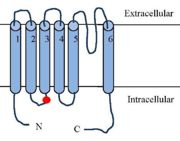Sandbox Reserved 1652
From Proteopedia
(Difference between revisions)
| Line 14: | Line 14: | ||
The TRPV1 receptor is a transmembrane protein receptor. It is made up of '''839 amino acids'''. It’s molecular weight is '''94 938Da'''.<ref name="Structure of the TRPV1 ion channel determined by electron cryo-microscopy">Liao, M., Cao, E., Julius, D., & Cheng, Y. (2013b). Structure of the TRPV1 ion channel determined by electron cryo-microscopy. Nature, 504(7478), 107‑112. https://doi.org/10.1038/nature12822(consulté le déc. 28, 2020)</ref> TRPV1 exists in two states : the open state and the closed state.<ref> T. Rosenbaum et S. A. Simon, « TRPV1 Receptors and Signal Transduction », in TRP Ion Channel Function in Sensory Transduction and Cellular Signaling Cascades, W. B. Liedtke et S. Heller, Éd. Boca Raton (FL): CRC Press/Taylor & Francis, 2007</ref> | The TRPV1 receptor is a transmembrane protein receptor. It is made up of '''839 amino acids'''. It’s molecular weight is '''94 938Da'''.<ref name="Structure of the TRPV1 ion channel determined by electron cryo-microscopy">Liao, M., Cao, E., Julius, D., & Cheng, Y. (2013b). Structure of the TRPV1 ion channel determined by electron cryo-microscopy. Nature, 504(7478), 107‑112. https://doi.org/10.1038/nature12822(consulté le déc. 28, 2020)</ref> TRPV1 exists in two states : the open state and the closed state.<ref> T. Rosenbaum et S. A. Simon, « TRPV1 Receptors and Signal Transduction », in TRP Ion Channel Function in Sensory Transduction and Cellular Signaling Cascades, W. B. Liedtke et S. Heller, Éd. Boca Raton (FL): CRC Press/Taylor & Francis, 2007</ref> | ||
| - | TRPV1 are '''tetrameric''' channel type receptors. The four subunits | + | TRPV1 are '''tetrameric''' channel type receptors. The four subunits form a symmetry plane around a pore allowing the passage of ions. |
| - | Each TRPV1 subunits | + | Each TRPV1 subunits is made of one '''N-terminal tail''', one '''transmembrane region''', a '''C-terminal tail''' preceded by a '''TRP domain'''. The N-terminal and C-terminal region are intracellular. N and C terminal region are responsible of 70% of the total mass of TRPV1.<ref name="Structure of the TRPV1 ion channel determined by electron cryo-microscopy"/> |
The<scene name='86/868185/Aterm/1'> N-terminal</scene> region has 6 repeats of [https://en.wikipedia.org/wiki/Ankyrin <scene name='86/868185/Ankyrin_residues_of_n-term/1'>ankyrin</scene>].<ref name="Structure of the TRPV1 ion channel determined by electron cryo-microscopy"/><ref name="Integrating TRPV1 Receptor Function with Capsaicin Psychophysics">G. Smutzer et R. K. Devassy, « Integrating TRPV1 Receptor Function with Capsaicin Psychophysics », Advances in Pharmacological Sciences, janv. 14, 2016</ref> | The<scene name='86/868185/Aterm/1'> N-terminal</scene> region has 6 repeats of [https://en.wikipedia.org/wiki/Ankyrin <scene name='86/868185/Ankyrin_residues_of_n-term/1'>ankyrin</scene>].<ref name="Structure of the TRPV1 ion channel determined by electron cryo-microscopy"/><ref name="Integrating TRPV1 Receptor Function with Capsaicin Psychophysics">G. Smutzer et R. K. Devassy, « Integrating TRPV1 Receptor Function with Capsaicin Psychophysics », Advances in Pharmacological Sciences, janv. 14, 2016</ref> | ||
The transmembrane region is composed of '''six transmembrane a helices''' (<scene name='86/868185/S1/1'>S1</scene>,<scene name='86/868185/S2/1'>S2</scene>,<scene name='86/868185/S3/1'>S3</scene>,<scene name='86/868185/S4/1'>S4</scene>,<scene name='86/868185/S5/1'>S5</scene>,<scene name='86/868185/S6/1'>S6</scene>). S1,S2 and S3 helices contain aromatic side chain (<scene name='86/868185/Y511_s512_t550/2'>Y511,S512,T550</scene>).<ref name="Structure of the TRPV1 ion channel determined by electron cryo-microscopy"/> A small hydrophobic domain beetween S5 and S6 with a <scene name='86/868185/Re_entrant_loop/1'>re-entrant loop</scene> constitutes the pore allowing the passage of ions through the TRPV1 receptor.<ref name="TRPV1"/><ref name="Structure of the TRPV1 ion channel determined by electron cryo-microscopy"/> | The transmembrane region is composed of '''six transmembrane a helices''' (<scene name='86/868185/S1/1'>S1</scene>,<scene name='86/868185/S2/1'>S2</scene>,<scene name='86/868185/S3/1'>S3</scene>,<scene name='86/868185/S4/1'>S4</scene>,<scene name='86/868185/S5/1'>S5</scene>,<scene name='86/868185/S6/1'>S6</scene>). S1,S2 and S3 helices contain aromatic side chain (<scene name='86/868185/Y511_s512_t550/2'>Y511,S512,T550</scene>).<ref name="Structure of the TRPV1 ion channel determined by electron cryo-microscopy"/> A small hydrophobic domain beetween S5 and S6 with a <scene name='86/868185/Re_entrant_loop/1'>re-entrant loop</scene> constitutes the pore allowing the passage of ions through the TRPV1 receptor.<ref name="TRPV1"/><ref name="Structure of the TRPV1 ion channel determined by electron cryo-microscopy"/> | ||
| - | '''Threonin''' residue (<scene name='86/868185/T550/1'>T550</scene>) and '''Tyrosin''' residue (<scene name='86/868185/Y511/2'>Y511</scene>) located on the fifth and the third transmembrane helices are very conserved. Threonin 550 and | + | '''Threonin''' residue (<scene name='86/868185/T550/1'>T550</scene>) and '''Tyrosin''' residue (<scene name='86/868185/Y511/2'>Y511</scene>) located on the fifth and the third transmembrane helices are very conserved. Threonin 550 and Tyrosin 511 are implicated in TRPV1 activation by [https://en.wikipedia.org/wiki/Vanilloids vanilloids] and in pain sensation.<ref>R. Kumar, A. Hazan, A. Basu, N. Zalcman, H. Matzner, et A. Priel, « Tyrosine Residue in the TRPV1 Vanilloid Binding Pocket Regulates Deactivation Kinetics », J. Biol. Chem., vol. 291, no 26, p. 13855‑13863, juin 2016, doi: 10.1074/jbc.M116.726372.</ref> |
The S6 domain links the receptor to the <scene name='86/868185/C_term/1'>C-terminal</scene> domain of TRPV1. The C-terminal is made of 150 amino acids and it contains '''<scene name='86/868185/Trp/1'>TRP domain</scene>'''.<ref name="Integrating TRPV1 Receptor Function with Capsaicin Psychophysics"/>.The TRP domain is made of 23-25 aminoacids with a alpha helical structure, it is found in many TRP family members.<ref name="Structure of the TRPV1 ion channel determined by electron cryo-microscopy"/> TRP domain is necessary for the formation of tetrameric TRPV1. | The S6 domain links the receptor to the <scene name='86/868185/C_term/1'>C-terminal</scene> domain of TRPV1. The C-terminal is made of 150 amino acids and it contains '''<scene name='86/868185/Trp/1'>TRP domain</scene>'''.<ref name="Integrating TRPV1 Receptor Function with Capsaicin Psychophysics"/>.The TRP domain is made of 23-25 aminoacids with a alpha helical structure, it is found in many TRP family members.<ref name="Structure of the TRPV1 ion channel determined by electron cryo-microscopy"/> TRP domain is necessary for the formation of tetrameric TRPV1. | ||
| Line 38: | Line 38: | ||
Bound capsaicin is oriented in a « tail-up, head down » configuration. In this configuration the vanillyl and amide groups of capsaicin form specific interactions with TRPV1,capsaicin is anchored into the receptor.<ref>F. Yang et al., « Structural mechanism underlying capsaicin binding and activation of the TRPV1 ion channel », Nat. Chem. Biol., vol. 11, no 7, Art. no 7, juill. 2015, doi: 10.1038/nchembio.1835.</ref> | Bound capsaicin is oriented in a « tail-up, head down » configuration. In this configuration the vanillyl and amide groups of capsaicin form specific interactions with TRPV1,capsaicin is anchored into the receptor.<ref>F. Yang et al., « Structural mechanism underlying capsaicin binding and activation of the TRPV1 ion channel », Nat. Chem. Biol., vol. 11, no 7, Art. no 7, juill. 2015, doi: 10.1038/nchembio.1835.</ref> | ||
| - | The capsaicin cycle binds via hydrogen bounds to amino acids on the S3 helix (<scene name='86/868185/Y511/1'>Y511</scene>), on the <scene name='86/868185/S4s5_linker/2'>S4-S5 linker</scene> and on the S6 helix (<scene name='86/868185/Tyr671/1'>T671</scene>). The amid group of capsaicin binds the S4 helix.<ref name="Integrating TRPV1 Receptor Function with Capsaicin Psychophysics"> | + | The capsaicin cycle binds via hydrogen bounds to amino acids on the S3 helix (<scene name='86/868185/Y511/1'>Y511</scene>), on the <scene name='86/868185/S4s5_linker/2'>S4-S5 linker</scene> and on the S6 helix (<scene name='86/868185/Tyr671/1'>T671</scene>). The amid group of capsaicin binds the <scene name='86/868185/S4/2'>S4</scene> helix.<ref name="Integrating TRPV1 Receptor Function with Capsaicin Psychophysics"> |
Capsaicin maintains TRPV1 in an open state by «pull and contact» interactions. A conformational change wave spread over the whole pore.<ref>F. Yang et al., « The conformational wave in capsaicin activation of transient receptor potential vanilloid 1 ion channel », Nat. Commun., vol. 9, no 1, Art. no 1, juill. 2018, doi: 10.1038/s41467-018-05339-6.</ref>. | Capsaicin maintains TRPV1 in an open state by «pull and contact» interactions. A conformational change wave spread over the whole pore.<ref>F. Yang et al., « The conformational wave in capsaicin activation of transient receptor potential vanilloid 1 ion channel », Nat. Commun., vol. 9, no 1, Art. no 1, juill. 2018, doi: 10.1038/s41467-018-05339-6.</ref>. | ||
Revision as of 15:55, 10 January 2021
| This Sandbox is Reserved from 26/11/2020, through 26/11/2021 for use in the course "Structural Biology" taught by Bruno Kieffer at the University of Strasbourg, ESBS. This reservation includes Sandbox Reserved 1643 through Sandbox Reserved 1664. |
To get started:
More help: Help:Editing |
The Transient Receptor Potential cation channel subfamily V member 1 TRPV1
| |||||||||||
References
- ↑ 1.0 1.1 1.2 Wikipedia contributors. (2020b, décembre 21). TRPV1. Wikipedia. https://en.wikipedia.org/wiki/TRPV1 (Consulté le: déc. 28, 2020). [En ligne].
- ↑ 2.0 2.1 2.2 2.3 2.4 2.5 Liao, M., Cao, E., Julius, D., & Cheng, Y. (2013b). Structure of the TRPV1 ion channel determined by electron cryo-microscopy. Nature, 504(7478), 107‑112. https://doi.org/10.1038/nature12822(consulté le déc. 28, 2020)
- ↑ T. Rosenbaum et S. A. Simon, « TRPV1 Receptors and Signal Transduction », in TRP Ion Channel Function in Sensory Transduction and Cellular Signaling Cascades, W. B. Liedtke et S. Heller, Éd. Boca Raton (FL): CRC Press/Taylor & Francis, 2007
- ↑ 4.0 4.1 4.2 4.3 G. Smutzer et R. K. Devassy, « Integrating TRPV1 Receptor Function with Capsaicin Psychophysics », Advances in Pharmacological Sciences, janv. 14, 2016
- ↑ R. Kumar, A. Hazan, A. Basu, N. Zalcman, H. Matzner, et A. Priel, « Tyrosine Residue in the TRPV1 Vanilloid Binding Pocket Regulates Deactivation Kinetics », J. Biol. Chem., vol. 291, no 26, p. 13855‑13863, juin 2016, doi: 10.1074/jbc.M116.726372.
- ↑ X. Yao, H.-Y. Kwan, et Y. Huang, « Regulation of TRP Channels by Phosphorylation », Neurosignals, vol. 14, no 6, p. 273‑280, 2005, doi: 10.1159/000093042
- ↑ F. Yang et J. Zheng, « Understand spiciness: mechanism of TRPV1 channel activation by capsaicin », Protein Cell, vol. 8, no 3, p. 169‑177, mars 2017, doi: 10.1007/s13238-016-0353-7.
- ↑ F. Yang et al., « Structural mechanism underlying capsaicin binding and activation of the TRPV1 ion channel », Nat. Chem. Biol., vol. 11, no 7, Art. no 7, juill. 2015, doi: 10.1038/nchembio.1835.
- ↑ F. Yang et al., « The conformational wave in capsaicin activation of transient receptor potential vanilloid 1 ion channel », Nat. Commun., vol. 9, no 1, Art. no 1, juill. 2018, doi: 10.1038/s41467-018-05339-6.
- ↑ K. Elokely et al., « Understanding TRPV1 activation by ligands: Insights from the binding modes of capsaicin and resiniferatoxin », Proc. Natl. Acad. Sci., vol. 113, no 2, p. E137‑E145, janv. 2016, doi:10.1073/pnas.1517288113.
- ↑ K. W. Ho, N. J. Ward, et D. J. Calkins, « TRPV1: a stress response protein in the central nervous system », Am. J. Neurodegener. Dis., vol. 1, no 1, p. 1‑14, avr. 2012.
- ↑ K. W. Ho, N. J. Ward, et D. J. Calkins, « TRPV1: a stress response protein in the central nervous system », Am. J. Neurodegener. Dis., vol. 1, no 1, p. 1‑14, avr. 2012.
- ↑ G. Bhave et al., « Protein kinase C phosphorylation sensitizes but does not activate the capsaicin receptor transient receptor potential vanilloid 1 (TRPV1) », Proc. Natl. Acad. Sci., vol. 100, no 21, p. 12480‑12485, oct. 2003, doi: 10.1073/pnas.2032100100.
- ↑ 14.0 14.1 A. Danigo, L. Magy, et C. Demiot, « TRPV1 dans les neuropathies douloureuses - Des modèles animaux aux perspectives thérapeutiques », médecine/sciences, vol. 29, no 6‑7, Art. no 6‑7, juin 2013, doi: 10.1051/medsci/2013296012.


